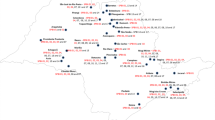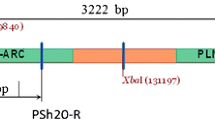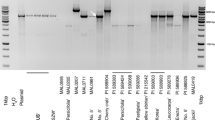Abstract
Bacterial fruit blotch (BFB), caused by Acidovorax citrulli, is an economically devastating disease in melon. Molecular characterization of causal strains and identification of sources of resistance are necessary to control this important disease. Many strains of BFB were identified by partial sequencing and documented in GenBank. Recently, there was an outbreak of BFB strain NIHHS15-280 in melon fields (Goksung, Jeonnam, Korea) that severely hampered melon production in Korea. For this reason, we characterized NIHHS15-280 by partially sequencing the 16S rRNA gene using PCR-based markers. The partial sequence of the 16S rRNA gene of NIHHS15-280 was much more similar to A. citrulli strains associated with melon and watermelon hosts than other cucurbit hosts. A PCR-based assay identified the strain (NIHHS15-280) as belonging to A. citrulli group I, which predominantly infects non-watermelon cucurbits (virulent to melon). Thirty-five melon genotypes were screened against NIHHS15-280 in a detached-leaf inoculation assay. The lack of visible disease symptoms 11 days after inoculation in lines PI353814 and PI140471 indicated these to be highly resistant lines, whereas moderate resistance was observed in lines PI420145 and SCNU1154 and cultivars ME6 and ME5. Also, the most resistant lines were corroborated by a fruit inoculation assay. The characterized A. citrulli strain NIHHS15-280 (group I) and identified resistant lines will serve as a valuable resource for further genetic studies and improvement of BFB resistance in melon.






Similar content being viewed by others
References
Adhikari M, Yadav DR, Kim SW, Um YH, Kim HS, Lee SC, Song JY, Kim HG, Lee YS (2017) Biological control of bacterial fruit blotch of watermelon pathogen (Acidovorax citrulli) with rhizosphere associated bacteria. Plant Pathol J 33:170
Assis S, Mariano R, Silva-Hanlin D, Duarte V (1999) Bacterial fruit blotch caused by Acidovorax avenae subsp. citrulli in melon in the state of Rio Grande do Norte, Brazil. Fitopatol Bras 24:119
Bahar O, Burdman S (2010) Bacterial fruit blotch: a threat to the cucurbit industry. Isr J Plant Sci 58:19–31
Bahar O, Kritzman G, Burdman S (2009) Bacterial fruit blotch of melon: screens for disease tolerance and role of seed transmission in pathogenicity. Eur J Plant Pathol 123:71–83
Burdman S, Walcott R (2012) Acidovorax citrulli: generating basic and applied knowledge to tackle a global threat to the cucurbit industry. Mol Plant Pathol 13:805–815
Burdman S, Kots N, Kritzman G, Kopelowitz J (2005) Molecular, physiological, and host-range characterization of Acidovorax avenae subsp. citrulli isolates from watermelon and melon in Israel. Plant Dis 89:1339–1347
Choi O, Cho SK, Kang B, Cho J, Park J, Lee Y, Kim J (2016) Two genetically distinct groups of Acidovorax citrulli are present in watermelon-growing fields in Korea. J Agric Life Sci 50:53–59
Clarridge JE (2004) Impact of 16S rRNA gene sequence analysis for identification of bacteria on clinical microbiology and infectious diseases. Clin Microbiol Rev 17:840–862
Conceição CS, Felix KCS, Mariano RL, Medeiros EV, Souza EB (2014) Combined effect of yeast and silicon on the control of bacterial fruit blotch in melon. Sci Hortic 174:164–170
de Melo EA, Rosa de Lima RM, Laranjeira D, dos Santos LA, de Omena Gusmão L, de Souza EB (2015) Efficacy of yeast in the biocontrol of bacterial fruit blotch in melon plants. Trop Plant Pathol 40:56–64
Eckshtain-Levi N, Shkedy D, Gershovits M, Da Silva GM, Tamir-Ariel D, Walcott R, Pupko T, Burdman S (2016) Insights from the genome sequence of Acidovorax citrulli M6, a group I strain of the causal agent of bacterial fruit blotch of cucurbits. Front Microbiol 7:430
Feng J, Schuenzel EL, Li J, Schaad NW (2009) Multilocus sequence typing reveals two evolutionary lineages of Acidovorax avenae subsp. citrulli. Phytopathology 99:913–920
Halfeld-Vieira BA, Nechet KdL (2007) Mancha-aquosa da melancia em Roraima. Fitopatol Bras 32:268
Hall TA (1999) BioEdit: a user-friendly biological sequence alignment editor and analysis program for Windows 95/98/NT. In: Nucleic acids symposium series, vol 41. Information Retrieval Ltd., c1979-c2000, London, pp 95–98
Han B, Rhee S, Jang Y, Sim T, Kim Y, Park T, Lee G (2016) Identification of a causal pathogen of watermelon powdery mildew in Korea and development of a genetic linkage marker for resistance in watermelon (Citrullus lanatus). Korean J. Hortic. Sci. & Technol. 34:912–923
Hassan MZ, Robin AHK, Rahim MA, Natarajan S, Kim H-T, Park J-I, Nou I-S (2018) Screening of melon genotypes identifies gummy stem blight resistance associated with Gsb1 resistant loci. J Plant Biotechnol 45:217–227
Hopkins D (1995) The hypothetical exam question becomes reality. Plant Dis 79:761–765
Hopkins D, Thompson C (2002) Evaluation of Citrullus sp. germ plasm for resistance to Acidovorax avenae subsp. citrulli. Plant Dis 86:61–64
Isakeit T, Black M, Barnes L, Jones J (1997) First report of infection of honeydew with Acidovorax avenae subsp. citrulli. Plant Dis 81:694
Isakeit T, Black M, Jones J (1998) Natural infection of citronmelon with Acidovorax avenae subsp. citrulli. Plant Dis 82:351
Langston D Jr, Walcott R, Gitaitis R, Sanders F Jr (1999) First report of a fruit rot of pumpkin caused by Acidivorax avenae subsp. citrulli in Georgia. Plant Dis 83:199
Latin R, Rane K (1990) Bacterial fruit blotch of watermelon in Indiana. Plant Dis 74(4):331–336
Martin H, Horlock C (2002) First report of Acidovorax avenae subsp. citrulli as a pathogen of Gramma in Australia. Plant Dis 86:1406
Martin H, O’Brien R, Abbott D (1999) First report of Acidovorax avenae subsp. citrulli as a pathogen of cucumber. Plant Dis 83:965
Nam NN, Kwon Y, Park J, Sim S (2019) Development of a core set of SSR markers for cultivar identification and seed purity tests in oriental melon (Cucumis melo L. var. makuwa). Hortic Sci Technol 37:119–129
Noh J, Kim J-H, Lim JH, Kim TB, Seong MH, Jung GT, Kim JM, Cheong S-S, Oh NK, Lee W-H (2014) Occurrence of diseases and case of clinical diagnosis on watermelon in South Korea, 2008-2012. Res Plant Dis 20:8–14
O’Brien R, Martin H (1999) Bacterial blotch of melons caused by strains of Acidovorax avenae subsp. citrulli. Aus J Exp Agric 39:479–485
Oliveira JC, Silveira EB, Mariano RL, Cardoso E, Viana IO (2007) Characterization of strains of Acidovorax avenae subsp. citrulli. Fitopatol Bras 32:480–487
Patel JB (2001) 16S rRNA gene sequencing for bacterial pathogen identification in the clinical laboratory. Mol Diagn 6:313–321
Rahimi-Midani A, Kim M-j, Kim S-h, Moon D-y, Lim J, Kim JH, Choi T-j (2018a) Isolation and characterization of a wide host range bacteriophage of Acidovorax citrulli and application for the control of bacterial fruit blotch. Korean Soc Plant Pathol Spring Conf 2018:49
Rahimi-Midani A, Lee YS, Kang S-W, Kim M-K, Choi T-J (2018b) First isolation and molecular characterization of bacteriophages infecting Acidovorax citrulli, the causal agent of bacterial fruit blotch. Plant Pathol J 34:59
Relman DA, Schmidt TM, MacDermott RP, Falkow S (1992) Identification of the uncultured bacillus of Whipple’s disease. N Engl J Med 327:293–301
Robbs C, Rodrigues Neto J, Ramos R, Sinigaglia C (1991) Mancha bacteriana da melancia no estado de São Paulo, causada por Pseudomonas pseudoalcaligenes subsp. citrulli. Fitopatol Bras 16:48
Sales Júnior R, Menezes J (2001) Mapeamento das doenças fúngicas, bacterianas e viróticas do cultivo do melão no Estado do RN. Mossoró Escola Superior de Agricultura de Mossoró
Schaad NW, Jones JB, Chun W (2001) Laboratory guide for the identification of plant pathogenic bacteria, vol 3. APS Press, Saint Paul
Schaad N, Postnikova E, Randhawa P (2003) Emergence of Acidovorax avenae subsp. citrulli as a crop threatening disease of watermelon and melon. In: Pseudomonas syringae and related pathogens. Springer, Dordrecht, pp 573–581
Schaad NW, Postnikova E, Sechler A, Claflin LE, Vidaver AK, Jones JB, Agarkova I, Ignatov A, Dickstein E, Ramundo BA (2008) Reclassification of subspecies of Acidovorax avenae as A. Avenae (Manns 1905) emend., A. cattleyae (Pavarino, 1911) comb. nov., A. citrulli Schaad et al., 1978) comb. nov., and proposal of A. oryzae sp. nov. Syst Appl Microbiol 31:434–446
Silva GM, Souza RM, Yan L, Júnior RS, Medeiros FH, Walcott RR (2016) Strains of the group I lineage of Acidovorax citrulli, the causal agent of bacterial fruit blotch of cucurbitaceous crops, are predominant in Brazil. Phytopathology 106:1486–1494
Slovareva O, Kornev K, Matyashova G, Stakheev A, Prikhodko S Recommended procedure for detection and identification Acidovorax citrulli in seeds. In: AIP conference proceedings, 2019, p 030020. AIP Publishing
Somodi GC, Jones J, Hopkins D, Stall R, Kucharek T, Hodge N, Watterson J (1991) Occurrence of a bacterial watermelon fruit blotch in Florida. Plant Dis 75:1053–1056
Song JY, Park SY, Seo MW, Nam MH, Lim HS, Lee S-C, Lee YS, Kim HG (2015) Genetic characteristics of Acidovorax citrulli population causing bacterial fruit blotch against cucurbits in Korea. Res Plant Dis 21:82–88
Song JY, Oo MM, Park SY, Seo MW, Lee S-C, Jeon NB, Nam MH, Lee YS, Kim HG, Oh S-K (2018) Analysis of intraspecific genetic diversity in Acidovorax citrulli causing bacterial fruit blotch on cucurbits in Korea. Korean J Environ Agric 45:575–582
Sowell G Jr, Schaad N (1979) Pseudomonas pseudoalcaligenes subsp. citrulli on watermelon: seed transmission and resistance of plant introductions. Plant Dis Rep 63:437–441
Srinivasa C, Sharanaiah U, Shivamallu C (2012) Molecular detection of plant pathogenic bacteria using polymerase chain reaction single-strand conformation polymorphism. Acta Biochim Biophys Sin 44:217–223
Thompson JD, Higgins DG, Gibson TJ (1994) CLUSTAL W: improving the sensitivity of progressive multiple sequence alignment through sequence weighting, position-specific gap penalties and weight matrix choice. Nucleic Acids Res 22:4673–4680
Walcott R, Gitaitis R (2000) Detection of Acidovorax avenae subsp. citrulli in watermelon seed using immunomagnetic separation and the polymerase chain reaction. Plant Dis 84:470–474
Walcott R, Fessehaie A, Castro A (2004) Differences in pathogenicity between two genetically distinct groups of Acidovorax avenae subsp. citrulli on cucurbit hosts. J Phytopathol 152:277–285
Wall G, Santos V (1988) A new bacterial disease on watermelon in the Mariana Islands. Phytopathology 78:1–9
Wall G, Santos V, Cruz F, Nelson D, Cabrera I (1990) Outbreak of watermelon fruit blotch in the Mariana islands. Plant Dis 74:80–86
Wechter WP, Levi A, Ling K-S, Kousik C, Block CC (2011) Identification of resistance to Acidovorax avenae subsp. citrulli among melon (Cucumis spp.) plant introductions. HortScience 46:207–212
Wilson K, Frothingham R, Wilson J, Blitchington R (1991) Phylogeny of the Whipple’s-disease-associated bacterium. The Lancet 338:474–475
Zivanovic M, Walcott R (2016) Further characterization of genetically distinct groups of Acidovorax citrulli strains. Phytopathology 107:29–35
Acknowledgements
This study was supported by the Center for Horticultural Seed Development (Golden Seed Grant Number: 213007-05-3-CG100) of the Ministry of Agriculture, Food and Rural Affairs in the Republic of Korea (MAFRA). We thank the Korean Agriculture Culture Collection (KACC), National Institute of Horticultural and Herbal Science (NIHHS), South Korea; the International Collection of Microorganisms from Plants (ICMP), New Zealand; and the School of Life Sciences, University of Warwick, UK, for providing bacterial strains.
Author information
Authors and Affiliations
Contributions
MRI prepared and cultured the samples, isolated DNA, performed wet lab experiments, analyzed the data, interpreted the results, and wrote the first draft of the manuscript. UKN and HJJ assisted in sequence analysis and PCR-based assays. MA assisted in wet lab experiments and in preparing the tables and figures. MRH extensively revised and finalized the manuscript. ISN, JIP, HTK, and MRH conceived the project and designed the study. All authors read and approved the final draft of the manuscript.
Corresponding author
Ethics declarations
Conflict of interest
The authors declare that they have no conflict of interest.
Additional information
Communicated by Sung-Chur Sim.
Publisher's Note
Springer Nature remains neutral with regard to jurisdictional claims in published maps and institutional affiliations.
Electronic supplementary material
Below is the link to the electronic supplementary material.
Rights and permissions
About this article
Cite this article
Islam, M.R., Hossain, M.R., Kim, HT. et al. Molecular characterization of Acidovorax citrulli strain NIHHS15-280 causing bacterial fruit blotch disease in Korea and screening of resistance sources in melon. Hortic. Environ. Biotechnol. 61, 115–126 (2020). https://doi.org/10.1007/s13580-019-00190-0
Received:
Revised:
Accepted:
Published:
Issue Date:
DOI: https://doi.org/10.1007/s13580-019-00190-0




